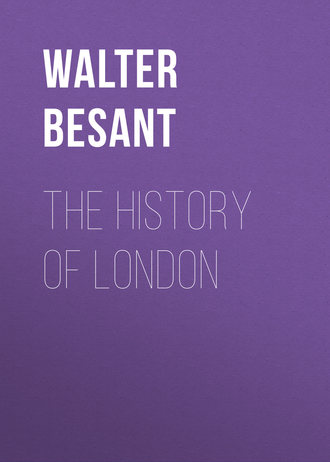 полная версия
полная версияThe History of London
These houses were occupied chiefly by shops, most of which were 'haberdashers and traders in small wares.' Later on there were many booksellers. Paper merchants and stationers, after the Reformation, occupied the chapel. The great painter Hans Holbein lived on the Bridge and the two marine painters Peter Monamy and Dominic Serres also lived here.
The narrowness of the arches and the rush of the flowing or the ebbing tide made the 'shooting' of the Bridge a matter of great danger. The Duke of Norfolk in 1429 was thrown into the water by the capsizing of his boat and narrowly escaped with his life. Queen Henrietta, in 1628, was nearly wrecked in the same way by running into the piers while shooting the Bridge. Rubens the painter was thrown into the water in the same way.
One of the twenty arches formed a drawbridge which allowed vessels of larger size than barges to pass up the river and could be used to keep back an enemy. In this way Sir Thomas Wyatt in 1557 was kept out of London. Before this drawbridge stood a tower on the battlements of which were placed the heads of traitors and criminals. The heads of Sir William Wallace, Jack Cade, Sir Thomas More and many others were stuck up here. On the Southwark side was another tower.
The Bridge, which was the pride and boast of London, was endowed with lands for its maintenance: the rents of the houses were also collected for the same purpose: a toll was imposed on all merchandise carried across, and a Brotherhood was formed, called the Brothers of St. Thomas on the Bridge, whose duty it was to perform service in the chapel and to keep the Bridge in repair.
Repairs were always wanting: to keep some of the force of the water off the piers these were furnished with 'starlings,' i.e. at first piles driven down in front of the piers, afterwards turned into projecting buttresses of stone. Then corn mills were built in some of the openings, and in the year 1582 great waterworks were constructed at the southern end. The tower before the drawbridge was by Queen Elizabeth rebuilt and made a very splendid house – called Nonesuch House. The Fire destroyed the houses on the Bridge, some of which were not rebuilt: and in the year 1757 all the houses were removed from the Bridge.
The New Bridge was finished and opened in 1831 – it stands 180 feet west of its predecessor. Then the Old Bridge was pulled down. The work of Peter Colechurch lasted from 1209 to 1831 or 622 years. The Pontife Brothers, therefore, knew how to put in good and lasting work.
This is the history of London Bridge. First a narrow wooden gangway of beams lying on timber piles with a fortified gate; then a stone structure of twenty irregular arches, the Bridge broad but the roadway still narrow with houses on either side and a fortress and a chapel upon it – in those times there was always a fortress, and there was always a chapel. It must have been a pleasant place of residence: the air fresh and clear: the supply of water unlimited – one drew it up in a bucket: always something going on: the entrance of a foreign ambassador, a religious procession, a riding of the Lord Mayor, a pageant, a nobleman with his livery, a Bishop or a Prior with his servants, a pilgrimage, a string of pack horses out of Kent bringing fruit for the City: always something to see. Then there were the stories and traditions of the place, with the songs which the children sang about the Bridge. Especially there was the story of Edward Osborne. He was the son of one Richard Osborne, a gentleman of Kent. Like many sons of the poor country gentlemen, he was sent up to London and apprenticed to Sir William Hewitt a cloth worker who lived on London Bridge. His master had a daughter named Anne, a little girl who one day, while playing with her nurse at an open window overhanging the river, fell out into the rushing water sixty feet below. The apprentice, young Osborne, leaped into the river after her and succeeded in saving her. When the girl was grown up her father gave her to his ex-apprentice, Edward Osborne, to wife. Edward Osborne became Lord Mayor. His descendant is now Duke of Leeds. So that the Dukedom of Leeds sprang from that gallant leap out of the window overhanging the river Thames from London Bridge.
17. THE TOWER OF LONDON
PART IIn an age when every noble's house was a castle, and when every castle was erected in order to dominate, as well as to defend, the town and the district in which it stood, the Tower of London was erected. The builder of the White Tower was William the Conqueror, who gave the City its Charter but had no intention of giving up his own sovereignty; the architect, as has been already said, was one Gundulph, Bishop of Rochester. Part of the City wall was pulled down to make room for it, and it was intended at once for the King's Palace, the King's Castle, and the King's Prison. It was also the key of London – who held the Tower, held the City.
William Rufus built a wall round the Tower so as to separate it entirely from the City and to prevent the danger of a hasty rising of the people: with the same object he gave it a water gate.
A hundred years later, while Richard Cœur de Lion was on his Crusade, the moat was constructed. Henry III. and his son Edward I. added to the outer walls and strengthened them.
There is a plan of the Tower made from a survey of the year 1597 and published by the Society of Antiquaries. A study of the plan should be made before visiting the place. Remark first of all that the fortress has three entrances only: one at the S.W. angle to the City; one to the river now called Traitors' Gate; and one on the S.E. angle called the Irongate: that it is surrounded by a broad and deep moat which could be filled at every high tide: that from the moat rises a battlemented wall, and that within this first wall is another, flanked with protecting towers; that the City entrance is most jealously guarded by a strong gate first: then by a narrow way passing under a tower: then over a bridge. In all mediæval castles the first thought was to make it impossible to carry the place by a rush. If we would restore the Tower of Queen Elizabeth to the Tower of Edward III. we must abolish all those buildings which stand on the north and east sides, with those called 'Lieutenants' Lodgings' on the south. The space on the north side of the Keep was the exercising ground: stables there must have been somewhere in this great area; the men at arms would live in the smaller towers. If you will study this plan carefully, you will understand the general arrangement of a mediæval castle.
In the sixteenth century the place was no longer regarded as a fortress for the defence or the domination of the City. But the old forms were kept up: nobody was admitted who carried arms: the guard kept the gate: a garrison was maintained. Within, there was an armoury, the beginning of the splendid collection which is now shown: there was a Mint for the coining of money: there were collections of tapestry, saddles, bed furniture and robes belonging to the Crown: here were kept the Crown and sceptre and insignia: here was the Royal menagerie. Here were the rooms reserved for state criminals. It was no longer the Royal Palace but the sovereign sometimes occupied the Tower. James the First was here, for instance, in 1604.
Near the outer gate where is now the Refreshment Room were kept the King's lions. Henry I. began this menagerie which was continued until the year 1834. At the entrance of the fortress is the Bell Tower where Queen Elizabeth was once confined. The Water Gate called Traitors' Gate is under St. Thomas's Tower. The Beauchamp Tower has been the prison of, among others, Queen Anne Boleyn and Lady Jane Grey. In the Great White Tower Richard II. abdicated in favour of Henry IV. In the vaults are dungeons, once the prison of Guy Fawkes. In the Chapel the newly made Knights of the Bath watched their armour all night long. The collection of arms contains examples of weapons and armour of every age. In the Church of St. Peter ad Vincula you will find the graves of the unfortunate Princes, Queens, and nobles who have been executed for State offences. Nothing, except the Royal tombs of Westminster, so much helps to prove the reality of History, as this collection of graves and slabs and tablets in this little church. And here were kept the Crown jewels about which many a chapter might be written.
But to study the Tower of London one must visit it with the History of England in hand. Hither were brought all the State prisoners: here they were confined: here they were executed. Every tower, every stone reminds one of sufferers and criminals and traitors and innocent victims. Do not, however, forget that this Tower was built for the restriction of the liberties of the people. That purpose has been defeated. The liberties have grown beyond what could ever have been hoped while the privileges of the Crown, which this Tower was built to protect and to enlarge, have been restricted beyond the greatest fears of the mediæval kings.
18. THE TOWER OF LONDON
PART IIOf all the prisoners who suffered death at the termination of their captivity in the Tower, there is none whose fate was so cruel as that of Lady Jane Grey. Her story belongs to English history. Recall, when next you visit the Tower, the short and tragic life of this young Queen of a nine days' reign.
She was not yet eighteen when she was beheaded, not through any fault of her own, but solely because her relationship to the Crown placed her in the hands of men who used her for their own political purposes. She was the second cousin of Edward VI., Mary, and Elizabeth. Her grandmother was the sister of Henry VIII., widow of Louis XII. of France, and wife of Charles, Duke of Suffolk. The young King on his deathbed was persuaded to name her as his successor. She was sixteen years of age: she was already married to Lord Guilford Dudley, son of the Duke of Northumberland: when she was proclaimed Queen. Nine days after the proclamation she was a prisoner. On the 8th of July she was acknowledged Queen by the Lord Mayor and Aldermen: on the 10th she was taken by water from Greenwich to the Tower, and proclaimed Queen in the City: on the 17th another proclamation was made of Queen Mary, and her reign was over. But the Tower she was never more to leave.
On the 13th of November – after five months of suspense – she was tried for high treason with Cranmer, her husband Lord Guilford, and her husband's brother, Lord Ambrose. They were all four found guilty, and condemned to death – their judges being the very men who had sworn allegiance to her as Queen. It would seem that Mary had no desire to carry out the sentence: Cranmer she reserved for a more cruel death than that of beheading – he was to be burned as a heretic. The other three, two boys and a girl, it would be dangerous to execute on account of the popular sympathy their death would awaken. They were therefore sent back to the Tower. Probably it was intended that Lady Jane, at least, should pass the rest of her life in honourable captivity, as happened later on to Arabella Stuart. But the rebellion of Wyatt showed that her name could still be used as a cry in favour of a Protestant succession. It was therefore resolved to put both husband and wife to death. What further harm the young Lord Guilford Dudley could do is not apparent. Even then the Queen's advisers shrank from exhibiting on Tower Hill the spectacle of a young and beautiful girl, taken forth to be beheaded because certain hot-headed partizans had used her name. She was executed therefore within the verge of the Tower itself, on the so-called 'Green.'
'The Green' is a place where no grass will grow – it used to be said – on account of the blood that had been shed upon it. Among the sufferers here was Hastings, executed by order of King Richard: Anne Boleyn: Katharine Howard: and Lady Jane Grey. A stone marks the spot on which the scaffold was set up.
It was on the morning of the 12th of February that Lady Jane Grey was put to death. She was then confined in the 'Brick' Tower, the residence of the Master of the Ordnance. From her window she saw the headless body of her husband brought back from Tower Hill in a cart. She looked upon it without shrinking. 'Oh! Guilford,' she said, 'the antipast is not so bitter after thou hast tasted, and which I shall soon taste, as to make my flesh tremble: it is nothing compared to the feast of which we shall partake this day in Heaven.' So she went forth with her two gentlewomen, Elizabeth Tylney and Mistress Helen, but she shed no tears. When she was on the scaffold she spoke to the officers of the Tower and the soldiers that stood around. No man or woman, however wise and dignified, could speak more clearly and with greater dignity than this girl of sixteen. They had been trying to make her a Catholic. Therefore, she made confession of the Protestant Faith: 'Good Christian people, bear witness that I die a true Christian woman and that I do look to be saved by no other means but only by the mercy of God, in the blood of his only son, Jesus Christ.'
So she made her gentlewomen bare her neck and bind her eyes and kneeling down laid her head upon the block, and while she was saying, 'Lord, into Thy hands I commend my spirit,' the axe fell and she was dead.
She lies buried before the altar of St. Peter's Church, near the bodies of the Queens Anne Boleyn and Katharine Howard.
So she died, this poor innocent child of whom all we know is that she was so scholarly that she could read Greek in the original: that she was beautiful: of a grave and sweet disposition: and raised far above the voice of calumny. She had, says Foxe, 'the innocency of childhood, the beauty of youth, the gravity of age: she had the birth of a princess, the learning of a clerk, the life of a saint, and the death of a malefactor for her parents' offences.'
19. THE PILGRIMS
In the time when the road connecting village with village and town with town was but an uncertain bridle path through woods and over waste places, where in winter horse, man, and wayfarer struggled with bog and quagmire, where robbers lurked in the thickets, and fevers and agues haunted the marsh, where men went armed and every stranger was a foe: it would seem as if most men stayed where they were born and desired not to court the dangers of the unknown world. In many villages, especially in the remote places of the country, this was the case. The men of Somerset abode where they were born, speaking their own language, a race apart: the men of Norfolk abode in their county cut off from the rest of the world by fens in the west and sea on the north and east: their language was not understood by the men of the west or the south country. Had the other conditions of life allowed this isolation to continue undisturbed, the nation could never have been created: we should have remained a scattered collection of tribes speaking each its own language and developing its own customs.
There were three causes which stirred the stagnant waters. The first was War. The Baron, or Feudal Lord, carried off the young men of the village to fight: those of them who returned had things to tell of the outside world. They fired the imagination and awakened the enterprise of the lads. The second was Trade at the trading ports: the lads saw, and continued to talk with, the foreign sailors – the Fleming, the German, the man of Rouen or Bordeaux: some of them went on board the ships of the merchant adventurers and sailed to foreign lands. Lastly, there were the Pilgrimages.
From the tenth to the fifteenth century there was a rage for pilgrimage. Everybody wanted to become a pilgrim. No money was wanted: there would certainly be found every day some monastery at which bed and a supper would be provided for the pilgrim: it was a joyous company which fared along the road, some riding, some on foot, travelling together for safety, all bound to the same shrine where they would hear the masses and make their vows and so return, light-hearted: it was, in fact, the mediæval way of taking a holiday. Sometimes it was to Canterbury, where was the shrine of Thomas Becket, that the pilgrims were bound: sometimes to Walsingham, where was the miraculous image of the Virgin: sometimes to Glastonbury, hallowed by the thorn miraculously flowering every year on Christmas Day, planted by Joseph of Arimathea himself: sometimes it was farther afield – to Compostella in Spain, Rome, or even Jerusalem – that the pilgrims proposed to go. Chaucer describes such a company all starting together, riding from London to Canterbury on pilgrimage to the shrine of Thomas Becket. They are pilgrims, but there is very little piety in their discourse: one can see that, whatever the motive, whether for the expiation of sin, or any other cause, the journey is full of cheerfulness and enjoyment. The Crusades were one outcome of this passion for pilgrimage. Nay, the first Crusade itself was little better than a great pilgrimage of the common people, so ignorant that they asked at the sight of every walled town if that was Jerusalem. It was a pilgrimage from which few, indeed, returned.
In England, the chief gain from pilgrimage was the bringing together of men from the different parts of the country. Remember that the men of the North could not understand the speech of the men of the South: a Norfolk rustic at the present day would hardly understand a man of Devon: there was always danger of forgetting that they all belonged to the same realm, the same nation, and the same race.
But the love of pilgrimage spread so wide that it became a danger. The rustic left the plough: the blacksmith his anvil: the carpenter his bench: all left their wives and their children in order to tramp across the country on pilgrimage to some shrine. By day they marched together: at night they sat round the fire in the strangers' room of the monastery, and took their supper and slept on the reeds. A delightful change from the monotony and hard work of the village! But the Bishops interposed. Let no one go on pilgrimage without his Bishop's license. Let not the monasteries give a bed and supper to any pilgrim who could not show his Bishop's license. Then the rustics and the craftsmen had to remain at home where they have stayed, except when they went out to fight, ever since.
When the pilgrim – especially the pilgrim who had been over the seas – came home, he was able to entertain his friends with stories he had seen all the rest of his life. Thus, the earliest plan of the Holy Sepulchre is one drawn by a pilgrim for the instruction of certain monks who entertained him. The pilgrims were the travellers of the time. They observed foreign manners and customs: they brought home seeds and told of strange food: they extended the boundaries of the world: they prevented the native village from becoming the whole world: they taught and encouraged men to cease from regarding a stranger as an enemy. The world was thus opened out by War, Trade, and Pilgrimage, but most of all by Pilgrimage.
20. ST. BARTHOLOMEW'S HOSPITAL
The oldest of the City Hospitals is that great and splendid Foundation which stands in Smithfield – the Smooth Field. It was first founded by one Rahere, of whom we know little or nothing except that he lived in the reign of Henry I., and that he founded the Priory and Monastery of St. Bartholomew. In the church of St. Bartholomew the Great you may see a very beautiful tomb said to be his, but the work is of a later date. It is related that while on a pilgrimage to Rome he fell ill and was like to die. And he vowed that if he were restored to health he would erect and establish a hospital for poor sick people. He did recover and he fulfilled his vow. He built the Priory of St. Bartholomew, whose church still stands in part and beside it established his hospital. The place called Smithfield was then a swampy field used for a horse fair: it was also a place of execution without the City wall. At first the hospital was a very small place. It consisted probably of two large rooms or halls, one for men and one for women – with a chapel. If it had any endowment at all it must have been very small, because the Master or Hospitaller had to go every morning to the Shambles, Newgate, in order to beg meat for the maintenance of the sick. Two hundred years later the hospital was taken in hand by Edward IV. and provided with an establishment of Master, eight brethren, priests, and four sisters, who served the sick. They were all subject to the Rule of St. Austin. After the death of Whittington, the hospital buildings were repaired by his bequests. On the dissolution of the religious houses, the Priory and Hospital of Bartholomew fell with the rest, but five years later the hospital was refounded and endowed by the King and the City.
If you visit a hospital and are taken into a ward, you see a row of clean white beds arranged in orderly position on either side of the long room: the temperature is regulated: the ventilation is perfect: there are means by which the patient can be examined in private: the diseases are apportioned to separate wards: every thing is managed with the greatest cleanliness and order: if an operation is performed the patient is kept under chloroform and feels nothing. The physicians are men of the highest scientific reputation: the nurses are trained assistants: the food is the best that can be procured. The poorest man brought to the hospital is treated with the same care, the same science, the same luxuries as the richest.
Look, however, at the hospital as founded by Rahere.
There is a great hall with a chapel at one end: at which mass is daily sung. The room is narrow and lofty, lit by Norman windows, two or three on a side: there is a lanthorn in the roof: under the lanthorn a fire is burning every day, the smoke rising to the roof: the hall is dark and ill ventilated, the air foul and heavy with the breath of sixty or seventy sick men lying in beds arranged in rows along the wall. There are not separate beds for each patient, but as the sick are brought in they are laid together side by side, in the same bed, whatever the disease, so that he who suffers from fever is placed beside another who suffers from palsy. There are four in a bed, and in times of pressure even more. Sometimes one arrives who develops the plague, when the whole of the patients in the hospital catch the infection and all die together. The surgeons are especially skilled in the dressing of wounds received in battle or in fray: the sisters can tie up a broken limb and stop a bleeding wound. The brethren go about the beds administering the last offices of the Church to the dying. The food is scanty: the appliances are rude: there is small hope of recovery: yet to die in hospital tended and consoled instead of in the hut where life has been passed is something for which to be grateful.
Consider into how great, how noble a Foundation the little hospital of Rahere has grown. The modern hospital contains 676 beds: it receives about 150,000 patients every year, of whom 7,000 are inpatients, 18,000 out patients, and 130,000 casuals. The eight brethren have become 30 physicians and surgeons besides the assistants called clinical clerks and dressers. The four sisters are now 159 sisters and nurses. There is a noble school of medicine: there are museums, libraries, lecture rooms, and there is a residential college for medical students: there is a convalescent hospital in the country. No hospital in the world has a larger or a more noble record than this of St. Bartholomew. And it all sprang from the resolution of one man, who started a humble house for the reception of the sick in a poor and despised place outside the City wall, but near to the Shambles where one could beg for broken victuals and for the pieces of meat that the butchers could not sell. Thus out of one good deed, apparently of small importance, has grown a never-ending stream of refreshment and healing. It has lasted for 700 years already: there seems no reason why it should ever stop.
21. THE TERROR OF LEPROSY
One mile outside the City walls, on the west, stood for four hundred years the Hospital of St. Giles in the Fields.
Here was a Lazar House, i.e. a Hospital for Lepers. It was founded by Maud, Queen of Henry I. It was dedicated to St. Giles because this saint was considered the protector of cripples. Hence the name Cripplegate, which really means the Little Gate, was applied to the church of St. Giles, and supposed to mean the gate near the church dedicated to the Patron Saint of Cripples. A common result of leprosy was to make the sufferer lame and crippled. Hence the connection. Generally, however, Lazarus, whom our Lord raised from the dead, was esteemed the Saint of Lepers, whence a Leper's Hospital was always called a Lazar House.











